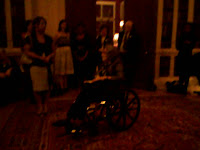 I’m back here at the Kimmel Center at NYU, blogging the session called “Diversity and Inclusion in Corporations and Academia,” moderated by Ana Duarte McCarthy, Lehman Brothers. The panelists are talking about how they each got into diversity work at their corporation or university. Here’s how:
I’m back here at the Kimmel Center at NYU, blogging the session called “Diversity and Inclusion in Corporations and Academia,” moderated by Ana Duarte McCarthy, Lehman Brothers. The panelists are talking about how they each got into diversity work at their corporation or university. Here’s how:
Subha Barry, Merrill Lynch:
“One of the best ways to see the diversity awakening is to see it happen around you. For me, it happened in my community. When I first moved to Princeton, NJ, I had to drive to Edison to go to Indian grocery stores, as there were no such stores in Princeton. And I thought, think about the amount of business we leave on the table simply because we don’t recognize the diversity around us.â€
Melinda Wolfe, American Express: “Whether it’s Goldman Sachs, Credit Suisse, Citigroup, or Merrill Lynch, the investment banking world is dog-eat-dog. It’s only been recently and through the efforts of the people around this table and others that we have been able to work cooperatively around diversity. Across firms, those of us who work in this field go around with linked arms. It’s not typically what you see among competitive firms. But we all recognize that it takes truly a village to fix this one.â€
Rosemary Cocetti, Georgetown University
“I got into my position because the President of the university created it and offered it to me.”
Anne Erni, Lehman Brothers
“I was on the trading floor, one of the few women who continued to move up. Most of my friends dropped out and became SAHMs. I got a call one day—the Friday of the last week in August—and I was taken aside and told by my boss: ‘Men run in packs. Women don’t. Go create your pack.’ Eventually, I was asked to leave the floor and become Chief Diversity Officer. And I told him, yes. You got me at hello.”
Ana Duarte-McCarthy next asks the million dollar question: What Makes Diversity Efforts Work? Some responses:
Melinda Wolfe: “If you don’t have breadth, depth, and leadership, your organization’s effort at diversity is not poised for success.â€
Anne Erni: “The firm set aside an 8-figure bonus pool to reward inclusion. When you’re on Wall Street, you’re entire focus during the year is on how much bonus you’re going to get. So we challenged each division to do an analysis and a plan. The head of each division then presented the outcome of their plan. Six months ago, we completed the fourth round of reviews. In the beginning, you could tell some of them had just been handed the powerpoint script and were struggling about whether to say ‘gay’ or ‘lesbian,’ ‘African American’ or ‘black’. My colleague asked one guy who was stumbling to close the book and just tell him from his heart what inclusion meant for him. The next year, he won.â€
Moving now to some Q&A…










